

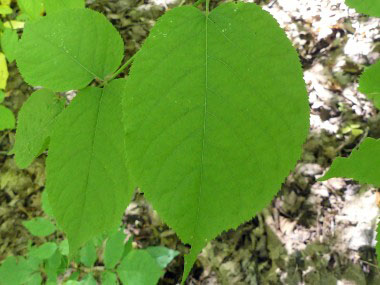
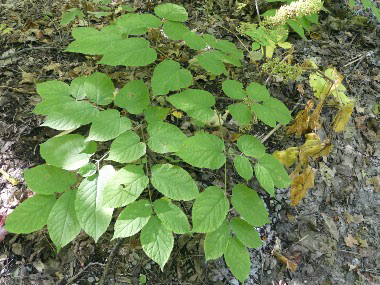
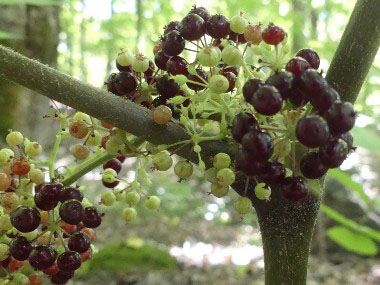
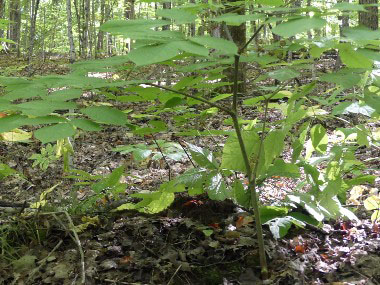

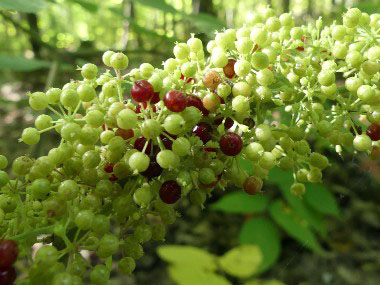
To support our efforts please browse our store (books with health benefits, etc.).
American Spikenard is a native erect perennial herbaceous forb, growing on shrubby stems. This plant may also be known by the common name Indian Root. This plant is in the Araliaceae (Ginseng Family). The genus Aralia is considered to be a Latinization of the old French-Canadian name aralie. The species racemosa means having a flowering raceme but in this case the flowers are not directly stalked off the stem of the raceme but instead the umbels are stalked off the raceme. Over time, the American Spikenard can form colonies of plants vegetatively from a rhizomatous root system that has a thick taproot. The plant also re-seeds. Aralia racemosa is a large, spreading, shrub-like plant at maturity, dying all the way back to the ground during the dormant season so is technically not a shrub.
Distinguishing Features
When the berries are in season it is very easy to identify this plant. It has the ginseng-like appearance and the stems are dark maroon to black. The leaves are very large, dark to light green colored, have oval, heart shaped leaflets with toothed margins and pointed tips.
Flowers
American spikenard flowers are 5-parted with small white to greenish triangular petals, which reflex when in flower. Sepals are green. Flowers are bisexual with 5 stamens, with white filaments. The ovary is ovoid in shape and has 5 styles united for half their length. Individual flowers open at different times. The inflorescence is a compound spreading panicle, up to 30cm (12") long, composed of rounded umbels, each umbel on a separate stalk and the entire inflorescence branching up from the top of the stem and sometimes from the leaf axils. Each umbel composed of individually stalked flowers. Flowers mature to a dark purple or reddish-brown rounded fleshy drupe.
 Fields
of Nutrition has medicinal benefits and vitamin/mineral content of American Spikenard.
Fields
of Nutrition has medicinal benefits and vitamin/mineral content of American Spikenard.
Leaves
The few, but large, compound leaves are divided into 3 main sections (on the rare occasion sometimes 4), each section is pinnately divided into 9 to 21 leaflets that are ovate, stalked, variable in size, sharply toothed and many times are double toothed. They taper to a pointed tip and have a heart-shaped base. Each leaflet can be 5 to 15cm (2-6") long. The veins on the leaflet underside and the leaflet stalk have fine hair.
Height
This plant can reach to just over 2 metres tall (7'); however, it is more commonly at a height of 1 metre (3').
Habitat
American spikenard is an understory shade tolerant plant that will grow in wet to mesic woodlands, thickets, and prairies. Although it can grow in full sun, it much prefers partial sun. It prefers moderately rich and well drained soils. This plant is native to the US and Canada although it occurs primarily in the northeast US and eastern Canada. There are Aralia species that are very similar and grow in other locations throughout the US and Canada.
Edible Parts
The fleshy berries that measure about 6 mm in size are edible; however, each fruit contains several light brown small seeds. The fruit has a very pleasant taste and can be used to make juice, fruit leather, jellies, etc. The berries typically do not ripen until September depending on geographical location. The root is aromatic and has a spicy taste. The tips of young shoots of this herb are cooked and also used as a potherb or in the form of flavouring in soups.
Other Name
Indian Root.
Similar Plants
Winter Survival Food Handbook

PDF Plant Magazines
Types of Wild Food
Geographic Zones Seasons
Disclaimer
EdibleWildFood.com is informational in nature. While we strive to be 100% accurate, it is solely up to the reader to ensure proper plant identification. Some wild plants are poisonous or can have serious adverse health effects.
We are not health professionals, medical doctors, nor are we nutritionists. It is up to the reader to verify nutritional information and health benefits with qualified professionals for all edible plants listed in this web site. Please click here for more information.
Why Edible Wild Food?
- Food costs are rising
- Free, wild food is readily abundant
- Wild food adds nutrition to your diet
- Wild food can help treat various medical conditions





